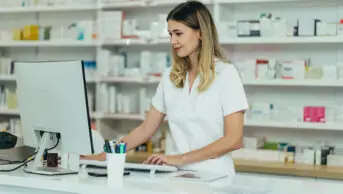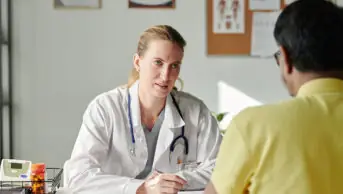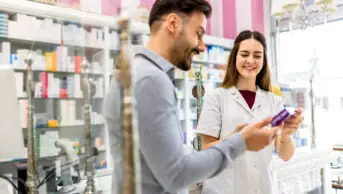England’s introduction of the additional roles reimbursement scheme (ARRS) in 2019 sparked a seismic shift in the GP pharmacy workforce[1]. This pioneering scheme emerged as a cornerstone of the health service’s response to surging demand for services. This is evident if we look back at workforce data from 2017, when there were only 584 pharmacists and 0 pharmacy technicians recorded to be working in GP practice settings[2]. NHS data published in December 2023 show a radical transformation, with 7,968 pharmacists and 2,393 pharmacy technicians now working across general practice and primary care networks (PCNs)[3,4].
This rapid expansion stands as a testament to the success of the pharmacy workforce within general practice. The significance of this change extends beyond workforce statistics: it symbolises a response to the escalating demands placed upon our healthcare system and demonstrates how a dynamic solution can be implemented rapidly at scale to meet the evolving needs of patient care.
Despite the expansion in the GP pharmacy workforce, concerns have surfaced regarding the implementation and integration of ARRS roles. A report published by The King’s Fund in 2022 revealed that these roles were often inadequately supported and poorly implemented[5]. These findings emphasised the importance of robust support mechanisms, encompassing clinical supervision and peer support for effective integration of ARRS roles with general practice. This sentiment was further emphasised in a poignant opinion piece by a senior GP pharmacist in The Pharmaceutical Journal, which drove home a stark reality: in many settings, there remains a lack of understanding of the value added by pharmacy roles, with many GP pharmacy professionals failing to successfully integrate into practice teams[6].
At South and East Leeds (SEL) GP Group (a GP Federation), an organisational pharmacy presence was established in 2015 with the head of clinical pharmacy. Then, in 2019 — to prepare for the challenges anticipated with a growing GP pharmacy workforce — SEL GP leadership was expanded to form the pharmacy support and development service, which includes an advanced pharmacist and advanced pharmacy technician. The service aims to facilitate training, provide peer support and offer clinical supervision for pharmacy professionals employed across the seven PCNs and member practices within SEL GP Group.
To understand the effectiveness of the service, an evaluation was conducted by assessing the current provision through an exploration of stakeholder perspectives and identification of satisfaction levels. Data were collected between January and February 2023 via two digital surveys sent by email to all SEL GP members, including PCN managers and clinical directors (n=13), and SEL GP pharmacy staff, including PCN pharmacy technicians and pharmacists (n=37). All surveys were anonymous and participants were made aware of this before completing the survey.
There was a 62% response rate from SEL GP members and 70% from SEL GP PCN pharmacy staff. For SEL GP members, 88% felt the service supported retention of pharmacy ARRS staff, 63% felt the service positively influenced their decision to recruit pharmacy ARRS staff, and 88% ‘agree’ or ‘strongly agree’ that offering this service is attractive to prospective employees. Overall, 88% described the service as ‘outstanding’ or ‘excellent’.
For PCN pharmacy staff, 96% felt the service helped them integrate as new starters, 100% agreed the service supported understanding of their role, 96% felt they receive appropriate support and supervision and 88% ‘agree’ or ‘strongly agree’ that having this service aids recruitment of pharmacy ARRS roles. Overall, 85% felt ‘very satisfied’ with the service.
Our results demonstrate that the pharmacy support and development service at SEL GP Group is favourably perceived by stakeholders and, so far, it has had a positive impact on the integration and continued recruitment of pharmacy ARRS staff. We acknowledge that 38% of SEL GP members and 30% of SEL GP PCN pharmacy staff did not return the questionnaires, which represents a potential limitation. Nevertheless, the overwhelmingly positive feedback from those who participated indicates the success of the service. We propose that the pharmacy support and development service has been instrumental in staff retention and integration into practice teams.
Moving forward, we are considering if it is valuable to adopt this effective model for non-pharmacy ARRS staff within SEL GP Group, potentially extending the positive impact of the service to a broader range of healthcare professionals. We also hope that the success of the pharmacy support and development service at SEL GP Group serves as a promising example for other GP practices, PCNs and GP federations aiming to enhance the integration and support of additional roles in primary care.
Best practice principles we would recommend based on our model:
- Needs assessment: identify challenges and requirements of pharmacy professionals in your team, considering varying expertise levels;
- Leadership involvement: involve leadership to champion and commit resources to ensure sustained service enhancement;
- Tailored training: develop training addressing the unique needs of your pharmacy team;
- Peer support networks: establish networks to facilitate collaboration, knowledge sharing, and mutual assistance among pharmacy professionals;
- Clinical supervision: support senior professionals in creating structured clinical supervision frameworks for guidance, feedback, and a platform for discussing challenging cases;
- Flexible support models: recognise diverse needs and offer flexible support, considering part-time or flexible working;
- Feedback mechanisms: ensure there are channels to provide feedback about the effectiveness of the support service (e.g. surveys or meetings) and use it to make continuous improvements and address emerging needs.
Hadeel Mohamed, deputy head of clinical pharmacy and education lead at SEL GP Group; Sue Alldred, head of clinical pharmacy at SEL GP Group; Sadiya Tabassum, advanced pharmacy technician at SEL GP Group. Any correspondence relating to the piece can be sent to: hadeel.mohamed@nhs.net
- 1General Practice: Expanding our workforce. NHS England. https://www.england.nhs.uk/gp/expanding-our-workforce (accessed February 2024)
- 2NHS Workforce Projections 2022. The Health Foundation. 2022. https://www.health.org.uk/publications/nhs-workforce-projections-2022 (accessed February 2024)
- 3General Practice Workforce: Official Statistics. NHS Digital. 2023. https://digital.nhs.uk/data-and-information/publications/statistical/general-and-personal-medical-services/31-december-2023 (accessed February 2024)
- 4Primary Care Network Workforce: Official Statistics. NHS Digital. 2023. https://digital.nhs.uk/data-and-information/publications/statistical/primary-care-network-workforce/31-december-2023 (accessed February 2024)
- 5Integrating Additional Roles into Primary Care Networks. The King’s Fund. 2022. https://www.kingsfund.org.uk/publications/integrating-additional-roles-into-primary-care-networks (accessed February 2024)
- 6Potential of pharmacists in general practice to improve care is being squandered. Pharmaceutical Journal. 2023. https://doi.org/10.1211/pj.2022.1.169777


